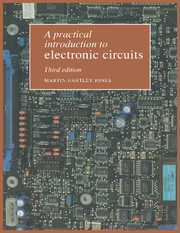Book contents
- Frontmatter
- Contents
- Preface to the third edition
- Preface to the second edition
- Preface to the first edition
- 1 Amplification and the transistor
- 2 The field-effect transistor
- 3 Thermionic valves and the cathode-ray tube
- 4 Negative feedback
- 5 Impedance matching
- 6 Semiconductor device characteristics
- 7 Amplification at high frequencies
- 8 Low-frequency signals, d.c. and the differential amplifier
- 9 Power supplies and power control
- 10 Pulse handling and time constants
- 11 Integrated circuit analogue building bricks
- 12 Positive feedback circuits and signal generators
- 13 Digital logic circuits
- 14 Microcomputer circuits and applications
- Appendix 1 Component identification
- Appendix 2 Transistor selection
- Appendix 3 Op amp data
- Appendix 4 Digital IC connections
- Appendix 5 Interfacing to the PC
- Bibliography
- Index
Preface to the second edition
Published online by Cambridge University Press: 05 June 2012
- Frontmatter
- Contents
- Preface to the third edition
- Preface to the second edition
- Preface to the first edition
- 1 Amplification and the transistor
- 2 The field-effect transistor
- 3 Thermionic valves and the cathode-ray tube
- 4 Negative feedback
- 5 Impedance matching
- 6 Semiconductor device characteristics
- 7 Amplification at high frequencies
- 8 Low-frequency signals, d.c. and the differential amplifier
- 9 Power supplies and power control
- 10 Pulse handling and time constants
- 11 Integrated circuit analogue building bricks
- 12 Positive feedback circuits and signal generators
- 13 Digital logic circuits
- 14 Microcomputer circuits and applications
- Appendix 1 Component identification
- Appendix 2 Transistor selection
- Appendix 3 Op amp data
- Appendix 4 Digital IC connections
- Appendix 5 Interfacing to the PC
- Bibliography
- Index
Summary
There have of course been many advances in electronics since the preparation of the first edition and this has been a welcome opportunity to bring the text up to date. The decade leap is reflected particularly in the two new chapters (13 and 14) on digital techniques and computers. Here I have aimed to present the important relationship of the microcomputer chip to other circuits, both digital and analogue, in a digestible form with plenty of experiments.
In the remainder of the book, many detailed changes have updated it without destroying the logical structure which has by now become familiar to students on many college and university courses. The approach throughout remains a practical one and is still based on my experience of teaching electronics in the Department of Pure and Applied Physics at UMIST. In recent years my work has been in industrial electronic design, further experience which has helped me to keep the text relevant to real applications.
In acknowledging gratefully the help I have received in preparing this second edition, I must first thank those readers of the first edition who wrote in with encouraging suggestions and amendments. Thank you too to my eldest son Christopher for his help in devising and testing the computer-based experiments. Alan Jubb was a great help in checking the manuscript of the new material.
Finally thank you again to my wife Sylvia not only for her typing skill but also for her encouragement and patience.
- Type
- Chapter
- Information
- Publisher: Cambridge University PressPrint publication year: 1995



